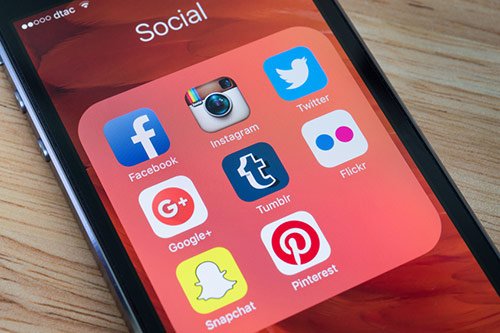These days, you can’t mutter the word marketing without accepting the role social media plays.
The basic tenet of pain management marketing is: “Go where your customers are.” It doesn’t take an expert to know that your prospective patients spend an overwhelming amount of time online, specifically on social media.
More than half of internet users use two or more of the mainstream social media sites (Facebook, Twitter, Instagram, Pinterest, and LinkedIn) daily, according to research from the Pew Research Center. These folks turn to social media not only to be entertained by silly memes, or angered by political rants; but to research, browse and buy.
Turning that focus to the healthcare industry, your prospective patients go to platforms like Facebook to compare practices, pore through reviews, and dissect the type of community you’ve built online.
In other words, patients use social media to make a decision on which healthcare practice to align with.
Are you do everything you can to make the most of the social media channels available?
Overcoming the hurdles of the social media abyss
 Chances are you find social media marketing to be akin to the Wild Wild West: there is no clear “best practices” strategy. Some people are drawn to this open-slate environment – the newness of social media marketing means they can test out-of-the-box ideas.
Chances are you find social media marketing to be akin to the Wild Wild West: there is no clear “best practices” strategy. Some people are drawn to this open-slate environment – the newness of social media marketing means they can test out-of-the-box ideas.
Others prefer to have a rigid guidebook, that helps them stay on target without missing a step.
Whichever method you’re more comfortable with, you’ll discover that formulating a social media calendar will help you stay organized and avoid feeling overwhelmed or lost in the digital woods.
Here are 4 quick tips to help you create a social media calendar that’ll grow your audience and increase traffic to your practice
1. Know which platforms work best for you
 There are several big-name social networks out there, but not every network is ideal for your practice or target audience.
There are several big-name social networks out there, but not every network is ideal for your practice or target audience.
You can’t expect to create personalized, high-quality content for every network out there, which is why you need to narrow down your addiction treatment advertising strategy to just a few platforms.
It all comes down to that marketing tenet: go where your audience is. Conduct market research (and survey your existing patients) to learn where they spend the most time.
Once you choose your networks, you want to create an Excel spreadsheet, with one worksheet (tab) for each social network. The reason to use a different worksheet per network is because each network requires its own type of messaging (and even frequency of publication).
That’s not to say you can’t promote the same content across several platforms at the same time; only, you should tailor each message to the network (for example, studies show using hashtags in a Facebook post actually drives people not to click, whereas with Twitter and Instagram, hashtags are essentially a must).
2. Start crafting and curating your content
 The purpose of your social media calendar is to plan out your posts well in advance. This means deciding on the content you want to post. Often times you’ll be posting content produced by others (known as content curation). Using tools like Feedly or Google Alerts can help you easily mine this content from reputable sources and publications.
The purpose of your social media calendar is to plan out your posts well in advance. This means deciding on the content you want to post. Often times you’ll be posting content produced by others (known as content curation). Using tools like Feedly or Google Alerts can help you easily mine this content from reputable sources and publications.
If/when you plan on promoting your own content, your social media calendar will help you and your team know what’s scheduled down the pipe. For example, if your calendar says that you plan to promote a blog post about the latest cancer research study from Australia next month, you (and your team, if applicable) know that this is a blog post that has to be published before then.
Be sure to populate each of your tabs. Ideally, you’ll schedule out your posts by day and time, so that you can analyze this data later on (more on that in #4). When crafting the posts for each network, keep in mind best-practices and space limitations. For example, Twitter currently allows only 140 characters.
Pro tip: Be sure to affix an image to every post, as images help improve clicks.
In Facebook, Twitter, and LinkedIn, these images might automatically populate based on the meta data provided by the original publisher. However, to avoid mishaps, affix an image to each of your scheduled posts, just so you aren’t left scrambling at the last second.
3. Capitalize on trending topics in your field
 Social media has turned every day into something. Whether it’s National Nurses Week, Breast Cancer Awareness Month, or staff birthdays, these occasions should find their way onto your social media calendar.
Social media has turned every day into something. Whether it’s National Nurses Week, Breast Cancer Awareness Month, or staff birthdays, these occasions should find their way onto your social media calendar.
Include related hashtags to be sure that your messaging finds a wider audience.
Think about creative ways you can stand out with your social post. Perhaps you can include a GIF, a captivating image, or tie in a related service offer or blog post you’ve published.
4. Use your calendar as an analytics tool
Here’s a helpful tip: Calendars are not just for looking forward. The information you capture on your spreadsheet will help you continuously optimize and improve your mental health marketing strategy.
Take a look at past months and mark what kinds of posts generated the most views or shares. What times and days seemed to be most effective? Which platforms are gaining the most traffic?
As you become a social media pro, you’ll discover that once you master a few basic practices, you can actually enjoy a tremendous return on investment, without having to dedicate a vast amount of time or energy, in large part due to the ongoing analysis of your calendar.
Tools to use to make the most of your social media
Everything we’ve mentioned here assumes you’ll be using a standard Excel spreadsheet as your calendar. However, we’ve known many folks who’ve turned to other services, such as a project management tool like Asana. These tools aren’t as flexible as a blank spreadsheet, but they do feature some add-ons that could be helpful, particularly if you work with a team.
Asana, for example, allows you to assign tasks/projects to specific people.
The other thing to consider is how you’ll schedule your posts in advance. Most social networks don’t let you schedule out a full month of updates within the platform itself.
Two of the most popular tools to help you schedule posts (and gather analytics) are Buffer and Hootsuite.
Both software solutions offer free (albeit limited) plans; our social media marketing agency recommends you test out both of them and choose the one that meets most of your needs and/or offers an interface you’ll be comfortable spending considerable time with.

